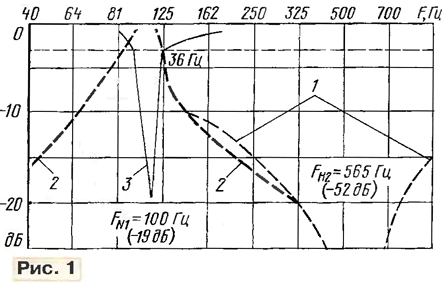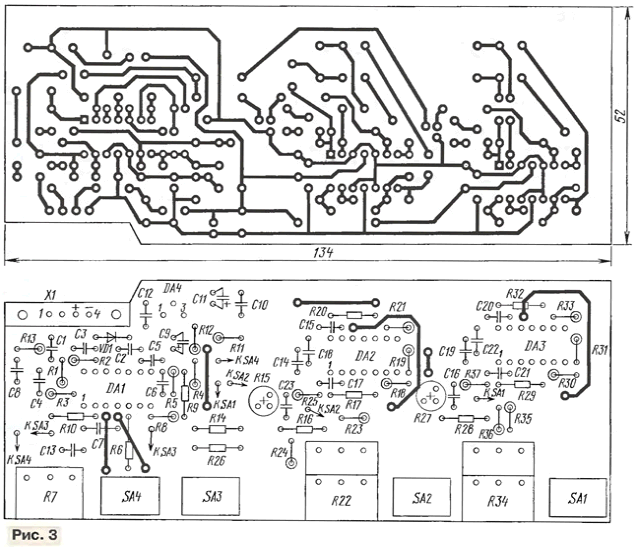
|
|
ENCYCLOPEDIA OF RADIO ELECTRONICS AND ELECTRICAL ENGINEERING Filter module to combat acoustic feedback. Encyclopedia of radio electronics and electrical engineering
Encyclopedia of radio electronics and electrical engineering / Speakers In the article, the author proposes a simple block of notch filters designed to work as part of a modular mixing console ("Radio", 2003, No. 2, 3) of a sound amplification system. This block allows you to suppress the spurious acoustic coupling between the microphones and the speaker system without any noticeable deterioration in quality. As already mentioned in the first article, a changeable set of modules significantly expands the scope of this compact console for sound recording and sound reinforcement. The biggest problem in amplification is usually the occurrence of acoustic feedback (“feedback”), and a large number of publications are devoted to combating it. To suppress this effect, there are many devices that have their own advantages and disadvantages. But it would be strange to recommend installing expensive digital filters or a frequency spectrum shifter into a simple amateur console [1]. Therefore, we will focus on simpler options. It is believed that most often the acoustic "tie" occurs in the frequency range of 125 Hz ... 4 kHz, primarily at frequencies of increased sensitivity of microphones and acoustic systems with their unfortunate location or the presence of sound reflections in the room. It is clear that in order to disrupt the generation in the sound amplification system, it is necessary either to reduce the gain or change the phase of the signal. With a decrease in the overall gain, the meaning of the sound amplification itself is lost. It is possible to apply a simple squelch and reduce the amplification of only low-level signals, but this method is useful if you need to amplify the voice of only one person. But sounds whose sources are farther from the microphone will be suppressed; this is not always acceptable. This means that it is necessary to reduce the signal gain only at the frequency at which the "tie" arose. This can be done with tunable notch filters. In order not to introduce noticeable frequency distortions into the signal, notch filters should be narrow-band. It is believed that "cutting" a frequency band from the signal spectrum with a width of less than 0,1 octaves is completely imperceptible even when listening to symphonic music, and in speech it is quite acceptable to increase this band to 0,2 ... 0,3 octaves. In practice, one-third-octave graphic equalizers successfully cope with this task, but they are very cumbersome. It is much more convenient to use parametric equalizers or narrow-band tunable notch filters. Usually narrow-band filters have a very large attenuation at the tuning frequency, but from their amplitude-frequency characteristics (AFC) it follows (curve 1 in Fig. 1) that a decrease in gain by 4 ... 5 dB occurs with a fairly wide band, and this is already detrimental to sound quality.
There is no need to introduce a large attenuation to eliminate the "string". Therefore, during operation, it would be possible not to use part of the frequency response of the notch filter: if 20 ... 30 dB is "cut off" in the upper part of the filter's frequency response, then the rejection band will become very narrow and the attenuation introduced by the filter will remain quite sufficient. The easiest way to solve this problem is to use a tunable narrow-band amplifier instead of a filter and mix (summ) the signal from the filter in antiphase with the main signal in the required proportion. This "proportion" will ensure the formation of the desired part of the frequency response. Curve 2 in fig. 1 shows the frequency response of a narrowband amplifier tuned to a frequency of 100 Hz, and curve 3 corresponds to the filter response taken at the output of the adder The module uses two such filters (Fig. 2), assembled on DA2 and DA3 microcircuits. The filter circuits are exactly the same and differ only in the values of the capacitors C15, C17 and C20, C21. The first of them can be tuned in the frequency band 50...750 Hz, and the second - in the band 0,5...7 kHz. If desired, you can change the quality factor and gain of the bandpass amplifier [2]. These parameters determine the following ratios of the resistances of the resistors in the filters: Q=R17/R18; K = R17/R16. It must be borne in mind that with a very narrow band of cut frequencies, it is difficult to tune in to the “tie” frequency and it is very easy to knock down the tuning. With a wide filter band, the frequency distortion introduced by it is noticeable by ear. Trimmer resistors R15 and R27 (SDR-19a) allow you to select the used part of the frequency response by setting the proportion of the summation of the signals. It should be remembered that when the filtering frequency is tuned, the gain of the bandpass amplifier changes somewhat. Each of the filters is turned on, if necessary, by toggle switches SA1, SA2. Sometimes it becomes necessary to enable both filters. The module additionally provides a tunable phase filter with op-amp DA1.3. Its circuit is much simpler, but by changing the phase of the signal, it is highly likely that generation will occur at a different frequency. In practice, to eliminate the high-frequency "tie", it is better to choose a capacitor C6 with a capacity of 2200 pF, and for a low-frequency one, increase it to 0,01 μF. In addition, the op-amp DA1.4, included as a phase inverter, allows using the SA3 toggle switch to change the phase in the amplification path immediately by 180 °. The remaining op-amps (DA1.1, DA1.2) operate respectively in the input and output stages. The output stage op amp simultaneously performs the function of an adder. When you turn on the filter unit in the console after the input line, you need to apply a signal directly to pin 13 of DA1. Instead of elements C1, R1, jumpers are installed, since a similar chain is already at the output of the input line. It can be seen from the diagram that the toggle switches allow you to turn on and off any link at will. Phase filters are turned off by the SA4 toggle switch (in the "OFF" position, the "bypass" mode), and the SA3 toggle switch switches the signal either to invert the signal phase, or to smoothly adjust the phase change. The design of the filter module is similar to the design of the amateur mixing console modules [1].
The printed circuit board drawing is shown in fig. 3, and the layout of the front panel of the module is shown in fig. 4.
The design uses TL084 chips (TL074, K1401UD4). All filter capacitors must be film capacitors, for example, K73-17 In practice, such a block almost always makes it possible to stably eliminate acoustic feedback. Filter adjustment must be done during the system performance check before the event and after that, do not move the speakers and microphones. By the way, in equipment with much more complex digital filters, if you change the relative position of the microphone and speakers, the filters are automatically reconfigured again. Literature
Author: E.Kuznetsov, Moscow
Artificial leather for touch emulation
15.04.2024 Petgugu Global cat litter
15.04.2024 The attractiveness of caring men
14.04.2024
▪ Complete absorption of light ▪ Automatic speed limit for electric scooters on sidewalks ▪ TRENDnet USB 3.0 Keyfob with IEEE 802.11ac Support
▪ site section Regulators of current, voltage, power. Article selection ▪ article to the left of common sense. Popular expression ▪ article Can you see a rainbow at night? Detailed answer ▪ article A simple bayonet with a hose. Tourist tips ▪ article Hectographic ink. Simple recipes and tips
Home page | Library | Articles | Website map | Site Reviews www.diagram.com.ua |






 Arabic
Arabic Bengali
Bengali Chinese
Chinese English
English French
French German
German Hebrew
Hebrew Hindi
Hindi Italian
Italian Japanese
Japanese Korean
Korean Malay
Malay Polish
Polish Portuguese
Portuguese Spanish
Spanish Turkish
Turkish Ukrainian
Ukrainian Vietnamese
Vietnamese




 Leave your comment on this article:
Leave your comment on this article: